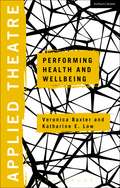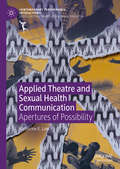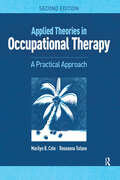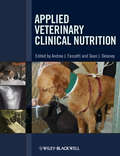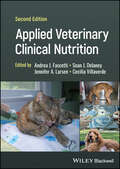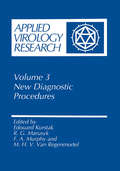- Table View
- List View
Applied Statistical Methods in Agriculture, Health and Life Sciences
by Bayo LawalThis textbook teaches crucial statistical methods to answer research questions using a unique range of statistical software programs, including MINITAB and R. This textbook is developed for undergraduate students in agriculture, nursing, biology and biomedical research. Graduate students will also find it to be a useful way to refresh their statistics skills and to reference software options. The unique combination of examples is approached using MINITAB and R for their individual strengths. Subjects covered include among others data description, probability distributions, experimental design, regression analysis, randomized design and biological assay. Unlike other biostatistics textbooks, this text also includes outliers, influential observations in regression and an introduction to survival analysis. Material is taken from the author's extensive teaching and research in Africa, USA and the UK. Sample problems, references and electronic supplementary material accompany each chapter.
Applied Statistics: A Handbook of Techniques (Springer Series in Statistics)
by Lothar SachsThis outline of statistics as an aid in decision making will introduce a reader with limited mathematical background to the most important modern statistical methods. This is a revised and enlarged version, with major extensions and additions, of my "Angewandte Statistik" (5th ed.), which has proved useful for research workers and for consulting statisticians. Applied statistics is at the same time a collection of applicable statistical methods and the application of these methods to measured and/or counted observations. Abstract mathematical concepts and derivations are avoided. Special emphasis is placed on the basic principles of statistical formulation, and on the explanation of the conditions under which a certain formula or a certain test is valid. Preference is given to consideration of the analysis of small sized samples and of distribution-free methods. As a text and reference this book is written for non-mathematicians, in particular for technicians, engineers, executives, students, physicians as well as researchers in other disciplines. It gives any mathematician interested in the practical uses of statistics a general account of the subject. Practical application is the main theme; thus an essential part of the book consists in the 440 fully worked-out numerical examples, some of which are very simple; the 57 exercises with solutions; a number of different compu tational aids; and an extensive bibliography and a very detailed index. In particular, a collection of 232 mathematical and mathematical-statistical tables serves to enable and to simplify the computations.
Applied Statistics: A Handbook of Techniques (Springer Series in Statistics)
by Lothar SachsAn English translation now joins the Russian and Spanish versions. It is based on the newly revised fifth edition of the German version of the book. The original edition has become very popular as a learning and reference source with easy to follow recipes and cross references for scientists in fields such as engineering, chemistry and the life sciences. Little mathematical background is required of the reader and some important topics, like the logarithm, are dealt with in the preliminaries preceding chapter one. The usefulness of the book as a reference is enhanced by a number of convenient tables and by references to other tables and methods, both in the text and in the bibliography. The English edition contains more material than the German original. I am most grateful to all who have in conversations, letters or reviews suggested improvements in or criticized earlier editions. Comments and suggestions will continue to be welcome. We are especially grateful to Mrs. Dorothy Aeppli of St. Paul, Minnesota, for providing numerous valuable comments during the preparation of the English manuscript. The author and the translator are responsible for any remaining faults and imperfections. I welcome any suggestions for improvement. My greatest personal gratitude goes to the translator, Mr. Zenon Reynaro wych, whose skills have done much to clarify the text, and to Springer-Verlag.
Applied Statistics for Agriculture, Veterinary, Fishery, Dairy and Allied Fields
by Pradip Kumar SahuThis book is aimed at a wide range of readers who lack confidence in the mathematical and statistical sciences, particularly in the fields of Agriculture, Veterinary, Fishery, Dairy and other related areas. Its goal is to present the subject of statistics and its useful tools in various disciplines in such a manner that, after reading the book, readers will be equipped to apply the statistical tools to extract otherwise hidden information from their data sets with confidence. Starting with the meaning of statistics, the book introduces measures of central tendency, dispersion, association, sampling methods, probability, inference, designs of experiments and many other subjects of interest in a step-by-step and lucid manner. The relevant theories are described in detail, followed by a broad range of real-world worked-out examples, solved either manually or with the help of statistical packages. In closing, the book also includes a chapter on which statistical packages to use, depending on the user’s respective requirements.
Applied Statistics for Network Biology: Methods in Systems Biology (Quantitative and Network Biology (VCH))
by Matthias Dehmer Frank Emmert-Streib Armin Graber Armindo SalvadorThe book introduces to the reader a number of cutting edge statistical methods which can e used for the analysis of genomic, proteomic and metabolomic data sets. In particular in the field of systems biology, researchers are trying to analyze as many data as possible in a given biological system (such as a cell or an organ). The appropriate statistical evaluation of these large scale data is critical for the correct interpretation and different experimental approaches require different approaches for the statistical analysis of these data. This book is written by biostatisticians and mathematicians but aimed as a valuable guide for the experimental researcher as well computational biologists who often lack an appropriate background in statistical analysis.
Applied Statistics for Network Biology: Methods in Systems Biology (Quantitative and Network Biology (VCH) #5)
by Matthias Dehmer Frank Emmert-Streib Armin Graber Armindo SalvadorThe book introduces to the reader a number of cutting edge statistical methods which can e used for the analysis of genomic, proteomic and metabolomic data sets. In particular in the field of systems biology, researchers are trying to analyze as many data as possible in a given biological system (such as a cell or an organ). The appropriate statistical evaluation of these large scale data is critical for the correct interpretation and different experimental approaches require different approaches for the statistical analysis of these data. This book is written by biostatisticians and mathematicians but aimed as a valuable guide for the experimental researcher as well computational biologists who often lack an appropriate background in statistical analysis.
Applied Statistics in Biomedicine and Clinical Trials Design: Selected Papers from 2013 ICSA/ISBS Joint Statistical Meetings (ICSA Book Series in Statistics)
by Zhen Chen Aiyi Liu Yongming Qu Larry Tang Naitee Ting Yi TsongThis volume is a unique combination of papers that cover critical topics in biostatistics from academic, government, and industry perspectives. The 6 sections cover Bayesian methods in biomedical research; Diagnostic medicine and classification; Innovative Clinical Trials Design; Modelling and Data Analysis; Personalized Medicine; and Statistical Genomics. The real world applications are in clinical trials, diagnostic medicine and genetics. The peer-reviewed contributions were solicited and selected from some 400 presentations at the annual meeting of the International Chinese Statistical Association (ICSA), held with the International Society for Biopharmaceutical Statistics (ISBS). The conference was held in Bethesda in June 2013, and the material has been subsequently edited and expanded to cover the most recent developments.
Applied Statistics in the Pharmaceutical Industry: With Case Studies Using S-Plus
by Steven P. Millard Andreas KrauseProviding a general guide to statistical methods used in the pharmaceutical industry, and illustrating how to use S-PLUS to implement these methods, the book explains why S-PLUS is a useful software package and discusses the results and implications of each particular application. It is targeted at graduates in biostatistics, statisticians involved in the industry as research scientists, regulators, academics, and/or consultants who want to know more about how to use S-PLUS and learn about other sub-fields within the industry, as well as statisticians in other fields who want to know more about statistical applications in the pharmaceutical industry.
Applied Surrogate Endpoint Evaluation Methods with SAS and R (Chapman & Hall/CRC Biostatistics Series)
by Ariel Alonso Theophile Bigirumurame Tomasz Burzykowski Marc Buyse Geert Molenberghs Leacky Muchene Nolen Joy Perualila Ziv Shkedy Wim Van der ElstAn important factor that affects the duration, complexity and cost of a clinical trial is the endpoint used to study the treatment’s efficacy. When a true endpoint is difficult to use because of such factors as long follow-up times or prohibitive cost, it is sometimes possible to use a surrogate endpoint that can be measured in a more convenient or cost-effective way. This book focuses on the use of surrogate endpoint evaluation methods in practice, using SAS and R.
Applied Surrogate Endpoint Evaluation Methods with SAS and R (Chapman & Hall/CRC Biostatistics Series)
by Ariel Alonso Theophile Bigirumurame Tomasz Burzykowski Marc Buyse Geert Molenberghs Leacky Muchene Nolen Joy Perualila Ziv Shkedy Wim Van der ElstAn important factor that affects the duration, complexity and cost of a clinical trial is the endpoint used to study the treatment’s efficacy. When a true endpoint is difficult to use because of such factors as long follow-up times or prohibitive cost, it is sometimes possible to use a surrogate endpoint that can be measured in a more convenient or cost-effective way. This book focuses on the use of surrogate endpoint evaluation methods in practice, using SAS and R.
Applied Survival Analysis Using R (Use R!)
by Dirk F. MooreApplied Survival Analysis Using R covers the main principles of survival analysis, gives examples of how it is applied, and teaches how to put those principles to use to analyze data using R as a vehicle. Survival data, where the primary outcome is time to a specific event, arise in many areas of biomedical research, including clinical trials, epidemiological studies, and studies of animals. Many survival methods are extensions of techniques used in linear regression and categorical data, while other aspects of this field are unique to survival data. This text employs numerous actual examples to illustrate survival curve estimation, comparison of survivals of different groups, proper accounting for censoring and truncation, model variable selection, and residual analysis.Because explaining survival analysis requires more advanced mathematics than many other statistical topics, this book is organized with basic concepts and most frequently used procedures covered in earlier chapters, with more advanced topics near the end and in the appendices. A background in basic linear regression and categorical data analysis, as well as a basic knowledge of calculus and the R system, will help the reader to fully appreciate the information presented. Examples are simple and straightforward while still illustrating key points, shedding light on the application of survival analysis in a way that is useful for graduate students, researchers, and practitioners in biostatistics.
Applied Systems Thinking for Health Systems Research: a Methodological Handbook (UK Higher Education Humanities & Social Sciences Health & Social Welfare)
by Don De Savigny Karl Blanchet Taghreed AdamPatient safety in health systems has become more and more important as a theme in health research, and so it is not surprising to see a growing interest in applying systems thinking to healthcare. However there is a difficulty – health systems are very complex and constantly adapting to respond to core drivers and fit needs. How do you apply systems thinking in this situation, and what methods are available? National health authorities, international donors and research practitioners need to know the “how-to” of conducting health systems research from a systems thinking perspective. This book will fill this gap and provide a range of tools that give clear guidance of ways to carry out systems thinking in health. These methodologies include:System dynamics and causal loopsNetwork analysisOutcome mappingSoft systems methodologyWritten by an international team of experts in health research, this handbook will be essential reading for those working in or researching public health, health policy, health systems, global health, service improvement and innovation in practice.
Applied Theatre: Performing Health and Wellbeing (Applied Theatre)
by Veronica Baxter Katharine E. Low Michael Balfour Sheila PrestonApplied Theatre: Performing Health and Wellbeing is the first volume in the field to address the role that theatre, drama and performance have in relation to promoting, developing and sustaining health and wellbeing in diverse communities. Challenging concepts and understanding of health, wellbeing and illness, it offers insight into different approaches to major health issues through applied performance. With a strong emphasis on the artistry involved in performance-based health responses, situated within a history of the field of practice, the volume is divided into two sections:Part One examines some of the key questions around research and practice in applied performance in health and wellbeing, specifically addressing the different regional challenges that dominate the provision of health care and influence wellbeing: how the ageing population of the global north creates pressure on lifetime healthcare provision, while the global south is dominated by a higher birth rate and a larger population under 15 years old. Part Two comprises case studies and interviews from international practitioners that reflect the diversity of practices across the world and in particular differences between work in the northern and southern hemispheres. These case studies include a sanitation project in a Hmong refugee camp in Thailand in the 1980s, and the sanitation and rural development projects initiated by the travelling theatre troupes of a number of University theatre departments in Africa – Makerere in Kampala, Uganda; Botswana; Lesotho and Dar es Salaam, Tanzania – which began in the 1960s. It considers the emergence of Theatre for Development's use as a health approach, considering the work of Laedza Batanani and the influences of Augusto Boal's Theatre of the Oppressed.
Applied Theatre: Performing Health and Wellbeing (Applied Theatre)
by Veronica Baxter Katharine E. Low Michael Balfour Sheila PrestonApplied Theatre: Performing Health and Wellbeing is the first volume in the field to address the role that theatre, drama and performance have in relation to promoting, developing and sustaining health and wellbeing in diverse communities. Challenging concepts and understanding of health, wellbeing and illness, it offers insight into different approaches to major health issues through applied performance. With a strong emphasis on the artistry involved in performance-based health responses, situated within a history of the field of practice, the volume is divided into two sections:Part One examines some of the key questions around research and practice in applied performance in health and wellbeing, specifically addressing the different regional challenges that dominate the provision of health care and influence wellbeing: how the ageing population of the global north creates pressure on lifetime healthcare provision, while the global south is dominated by a higher birth rate and a larger population under 15 years old. Part Two comprises case studies and interviews from international practitioners that reflect the diversity of practices across the world and in particular differences between work in the northern and southern hemispheres. These case studies include a sanitation project in a Hmong refugee camp in Thailand in the 1980s, and the sanitation and rural development projects initiated by the travelling theatre troupes of a number of University theatre departments in Africa – Makerere in Kampala, Uganda; Botswana; Lesotho and Dar es Salaam, Tanzania – which began in the 1960s. It considers the emergence of Theatre for Development's use as a health approach, considering the work of Laedza Batanani and the influences of Augusto Boal's Theatre of the Oppressed.
Applied Theatre and Sexual Health Communication: Apertures of Possibility (Contemporary Performance InterActions)
by Katharine E. LowThis book analyses the partnership between applied theatre and sexual health communication in a theatre-making project in Nyanga, a township in South Africa. By examining the bridges and schisms between the two fields as they come together in the project, an alternative way of approaching sexual health communication is advocated. This alternative considers what it is that applied theatre does, and could become, in this context. Moments of value which lie around the margins of the practice emerge as opportunities that can be overlooked. These somewhat ephemeral, intangible moments, which appear on the edges, are described as ‘apertures of possibility’ and occur when one takes a step back and realises something unnoticed in the moment. This book offers an invitation to pause and notice the seemingly insignificant moments that often occurs tangentially to the practice. The book also calls for more outcry about sexual health and sexual violence, arguing for theatre-making as a route to multitudes of voices, nuanced understandings, and diverse spaces in which discussions of sexuality and sexual health are shared, felt, and experienced.
Applied Theories in Occupational Therapy: A Practical Approach
by Marilyn B. Cole Roseanna TufanoApplied Theories in Occupational Therapy: A Practical Approach, Second Edition provides a system-based, comprehensive overview of the theories, models, and frames of reference that influence occupational therapy around the world. Esteemed authors Marilyn B. Cole and Roseanna Tufano have updated their foundational text with an evidence-based focus derived from their experiences of more than 30 years teaching theoretical content to students. Applied Theories in Occupational Therapy: A Practical Approach, Second Edition offers practical templates to help readers learn the key constructs of each theory and assimilate knowledge based on Mosey’s organizational structure. Each theory-based chapter is designed for ease in gathering content knowledge and comparing theories in a distinctive manner. The book includes: Summaries of the current trends found in practice, along with external influential models of health and wellness impacting populations of concern Exploration of some of the most common occupation-based models around the world. Each model’s holistic conceptual nature is described, including theoretical assumptions and practice guidelines for evaluation and intervention Reviews of common frames of reference found in evidence-based practice, which address the secondary and tertiary needs of common populations In this Edition, learning activities and case-based analyses strengthen the application of theory into current practice contexts. Practical guidelines assist the reader in formulating an evaluation process and determining the relevant intervention strategies that promote occupational participation, engagement, and functioning across the lifespan and the continuum of health.Included with the text are online supplemental materials for faculty use in the classroom.
Applied Theories in Occupational Therapy: A Practical Approach
by Marilyn B. Cole Roseanna TufanoApplied Theories in Occupational Therapy: A Practical Approach, Second Edition provides a system-based, comprehensive overview of the theories, models, and frames of reference that influence occupational therapy around the world. Esteemed authors Marilyn B. Cole and Roseanna Tufano have updated their foundational text with an evidence-based focus derived from their experiences of more than 30 years teaching theoretical content to students. Applied Theories in Occupational Therapy: A Practical Approach, Second Edition offers practical templates to help readers learn the key constructs of each theory and assimilate knowledge based on Mosey’s organizational structure. Each theory-based chapter is designed for ease in gathering content knowledge and comparing theories in a distinctive manner. The book includes: Summaries of the current trends found in practice, along with external influential models of health and wellness impacting populations of concern Exploration of some of the most common occupation-based models around the world. Each model’s holistic conceptual nature is described, including theoretical assumptions and practice guidelines for evaluation and intervention Reviews of common frames of reference found in evidence-based practice, which address the secondary and tertiary needs of common populations In this Edition, learning activities and case-based analyses strengthen the application of theory into current practice contexts. Practical guidelines assist the reader in formulating an evaluation process and determining the relevant intervention strategies that promote occupational participation, engagement, and functioning across the lifespan and the continuum of health.Included with the text are online supplemental materials for faculty use in the classroom.
Applied Toxicology: Proceedings of the 1996 EUROTOX Congress Meeting Held in Alicante, Spain, September 22–25, 1996 (Archives of Toxicology #19)
by Jürg P. Seiler Eugenio VilanovaUltraviolet radiation, a component of sunlight, has been recognized by photobiologists, dermatologists, and oculists as a potential hazard for human health because of its genotoxic, carcinogenic and immunotoxic properties. Its effects on human health include the induction of skin cancers, ocular damage and impairment of immunity to certain infections. A few decennia ago it was demonstrated that UV photons can affect the activity of the immune system through interactions with the skin. This means that UV not only changes normal cells into cancer cells but also permits the outgrowth of the UV -transformed cells by depressing the immune system. An intriguing question is what interactions between UV radiation and the skin initiates alterations in immune function in the exposed skin and systemically, i. e. in other places than the exposed skin. During the last 20 years many studies have been performed in order to investigate the immunosuppressive activities of UVB in laboratory animals and in human volunteers. In particular effects of UVB radiation on resistance to tumours and skin associated infections have been examined. In addition, effects of UVB radiation on immune parameters such as contact hypersensitivity and delayed-type hypersensitivity (both type IV hypersensitivity reactions), mixed lymphocyte reactions, mixed skin lymphocyte reactions, antigen presentation and numbers and function of Langerhans cells have been studied intensively. The antigenicity of murine tumours which are caused by UVB radiation was one of the first items to be investigated (Kripke, 1974).
Applied Veterinary Clinical Nutrition
by Andrea J. Fascetti Sean J. DelaneyApplied Veterinary Clinical Nutrition provides current, clinically relevant nutritional advice intended for use in daily canine and feline practice. Highly practical, the book emphasizes solutions for integrating nutrition into clinical practice, with introductory chapters covering the foundation and science behind the recommendations and extensive references for further reading. Written by a group of leading veterinary nutritionists, Applied Veterinary Clinical Nutrition is a valuable resource on the principles of animal nutrition and feeding practices in healthy or diseased dogs and cats. The book begins with an overview of basic nutrition, energy requirements, and the basics of product guides, pet foods, home-prepared diets and dietary supplements. Subsequent chapters delve into feeding the healthy dog and cat, nutrition for weight management, and nutritional principles for a variety of diseases, with the final chapters covering enteral and parenteral nutrition. Applied Veterinary Clinical Nutrition is a daily reference for veterinary practitioners, students, and residents seeking authoritative information on feeding animals.
Applied Veterinary Clinical Nutrition
by Andrea J. Fascetti Sean J. DelaneyApplied Veterinary Clinical Nutrition provides current, clinically relevant nutritional advice intended for use in daily canine and feline practice. Highly practical, the book emphasizes solutions for integrating nutrition into clinical practice, with introductory chapters covering the foundation and science behind the recommendations and extensive references for further reading. Written by a group of leading veterinary nutritionists, Applied Veterinary Clinical Nutrition is a valuable resource on the principles of animal nutrition and feeding practices in healthy or diseased dogs and cats. The book begins with an overview of basic nutrition, energy requirements, and the basics of product guides, pet foods, home-prepared diets and dietary supplements. Subsequent chapters delve into feeding the healthy dog and cat, nutrition for weight management, and nutritional principles for a variety of diseases, with the final chapters covering enteral and parenteral nutrition. Applied Veterinary Clinical Nutrition is a daily reference for veterinary practitioners, students, and residents seeking authoritative information on feeding animals.
Applied Veterinary Clinical Nutrition
by Andrea J. Fascetti Sean J. Delaney Jennifer A. Larsen Cecilia VillaverdeApplied Veterinary Clinical Nutrition Well-referenced clinical resource for canine and feline nutrition, with expansions throughout and two new chapters covering birds and small mammals. Fully revised to reflect new advances and information throughout, the Second Edition of Applied Veterinary Clinical Nutrition presents current, authoritative information on all aspects of small companion animal nutrition. The book provides clinically oriented solutions for integrating nutrition into clinical practice, with introductory chapters covering the foundation and science behind the recommendations and extensive references for further reading in every chapter. With contributions from more than 25 leading veterinary nutritionists, Applied Veterinary Clinical Nutrition covers topics such as: Integration of nutrition into clinical practice, basic nutrition, energy requirements, and pet food regulations in North America and Europe that also apply to many other regions Using and reviewing pet food labels and product guides, feeding the healthy dog and cat, and abridged clinical nutrition topics for companion avian species & small mammals Commercial and home-prepared diets, and nutritional management of body weight and orthopedic, skin, and gastrointestinal diseases Nutritional management of exocrine, hepatobiliary, kidney, lower urinary tract, endocrine, cardiovascular, and oncological diseases as well as enteral and parenteral nutrition A valuable resource on the principles of small animal nutrition and feeding practices in health or disease, Applied Veterinary Clinical Nutrition is a widely trusted and practical daily reference for veterinary practitioners including specialists, residents, and students seeking expert information on feeding their canine, feline, avian, and small mammalian patients.
Applied Veterinary Clinical Nutrition
by Andrea J. Fascetti Sean J. Delaney Jennifer A. Larsen Cecilia VillaverdeApplied Veterinary Clinical Nutrition Well-referenced clinical resource for canine and feline nutrition, with expansions throughout and two new chapters covering birds and small mammals. Fully revised to reflect new advances and information throughout, the Second Edition of Applied Veterinary Clinical Nutrition presents current, authoritative information on all aspects of small companion animal nutrition. The book provides clinically oriented solutions for integrating nutrition into clinical practice, with introductory chapters covering the foundation and science behind the recommendations and extensive references for further reading in every chapter. With contributions from more than 25 leading veterinary nutritionists, Applied Veterinary Clinical Nutrition covers topics such as: Integration of nutrition into clinical practice, basic nutrition, energy requirements, and pet food regulations in North America and Europe that also apply to many other regions Using and reviewing pet food labels and product guides, feeding the healthy dog and cat, and abridged clinical nutrition topics for companion avian species & small mammals Commercial and home-prepared diets, and nutritional management of body weight and orthopedic, skin, and gastrointestinal diseases Nutritional management of exocrine, hepatobiliary, kidney, lower urinary tract, endocrine, cardiovascular, and oncological diseases as well as enteral and parenteral nutrition A valuable resource on the principles of small animal nutrition and feeding practices in health or disease, Applied Veterinary Clinical Nutrition is a widely trusted and practical daily reference for veterinary practitioners including specialists, residents, and students seeking expert information on feeding their canine, feline, avian, and small mammalian patients.
Applied Virology Research: New Diagnostic Procedures (Applied Virology Research #3)
by Edouard KurstakVolume 3 is devoted to the latest diagnostic technology for virus diseases, particularly molecular methodologies.
An Applied Visual Sociology: Picturing Harm Reduction
by Stephen ParkinExploring the value of photography and video as legitimate forms of social enquiry, An Applied Visual Sociology: Picturing Harm Reduction constitutes a guidebook for conducting applied visual sociology within health related or social science research projects, providing a full account of the visual research journey and presenting a tested template for conducting theoretically-driven, sociologically-informed research. Against the background of the growing popularity of visual methods, this book goes beyond using photographs for illustrative and descriptive purposes, to emphasise the importance of sociological, epistemological and analytical theory, together with methods of data collection and the presentation of images for applied purposes. As such, An Applied Visual Sociology: Picturing Harm Reduction offers a template for considering visual data as applied research, providing a full account of the manner in which visual methods can inform research and specific interventions, together with opportunities for students and practitioners to consider applied visual sociology in a series of practical or self-study tasks . It will therefore appeal not only to students and researchers involved in social and health-related qualitative research, or those seeking to conduct innovative visual projects within the social sciences, but also to scholars interested in research methods, visual ethnography and harm reduction approaches to drug use.
An Applied Visual Sociology: Picturing Harm Reduction
by Stephen ParkinExploring the value of photography and video as legitimate forms of social enquiry, An Applied Visual Sociology: Picturing Harm Reduction constitutes a guidebook for conducting applied visual sociology within health related or social science research projects, providing a full account of the visual research journey and presenting a tested template for conducting theoretically-driven, sociologically-informed research. Against the background of the growing popularity of visual methods, this book goes beyond using photographs for illustrative and descriptive purposes, to emphasise the importance of sociological, epistemological and analytical theory, together with methods of data collection and the presentation of images for applied purposes. As such, An Applied Visual Sociology: Picturing Harm Reduction offers a template for considering visual data as applied research, providing a full account of the manner in which visual methods can inform research and specific interventions, together with opportunities for students and practitioners to consider applied visual sociology in a series of practical or self-study tasks . It will therefore appeal not only to students and researchers involved in social and health-related qualitative research, or those seeking to conduct innovative visual projects within the social sciences, but also to scholars interested in research methods, visual ethnography and harm reduction approaches to drug use.










